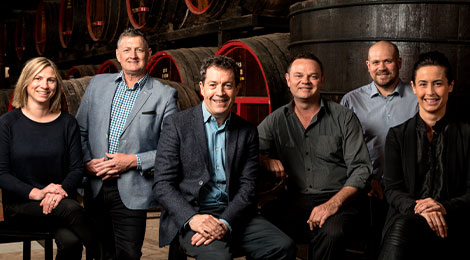Superblend 802.B Cabernet Shiraz 2018 Gift Box
Penfolds
Superblend 802.B Cabernet Shiraz 2018 Gift Box
Overview
Overview
One Superblend. Two Interpretations. Curiosity and experimentation delivers two new wines made from parcels destined for Penfolds flagships.
Carefully selected from the coveted 2018 South Australian vintage, the wines represent two unique interpretations of the iconic Australian blend of cabernet sauvignon and shiraz. 802.B varietal composition is close to evenly split with cabernet sauvignon contributing 55% and shiraz 45% of the blend respectively. The components were married immediately post vintage, completing 19 months maturation as a blend in French oak hogsheads.This wine will reward careful cellaring for several decades. An intriguing counterpoint to its American oak sibling.
| Varietal | Cabernet Sauvignon Shiraz |
|---|---|
| Vintage | 2018 |
| Country | Australia |
| Region | Multi Region |
| Volume | 750 mL |
| Closure | Cork |
| Alc/Vol | 14.5% |
| Peak Drinking | 2028 – 2055 |
| Winemaker | The Penfolds Team |
Awards and Accolades
Awards and Accolades
| 98 Points | Tyson Stelzer |
| 97 Points | Ken Gargett |
| 19.5+ Points | Matthew Jukes |
| 18.5 Points | Richard Hemming MW |
Tyson Stelzer
"55/45% cabernet sauvignon/shiraz, from Barossa Valley, McLaren Vale, Coonawarra, Wrattonbully, Robe and the Clare Valley. Matured, fully blended, for 19 months in 54% new French oak hogsheads; 5000 cases. Blending just post-harvest is virtually unheard of at Penfolds, and the effect of maturing almost equal proportions of cabernet and shiraz together is a harmony and integration astonishing in a youthful blend of such monumental longevity. The 2 varieties entwine seamlessly with French oak, with the tension of cabernet and the body of shiraz interlocking with dark chocolate and coffee bean. Tannins are superfine and mineral, laying out a grand trail of longevity that meets every bit of expectation in the grand lineage of Penfolds blends. A world away from Superblend A, yet intrinsically aligned to the very letter of its DNA. The pair beg the question of picking favourites, but for me they are both profoundly unique yet impossible to separate. Ask me again in 2 decades. 98 Points."
Ken Gargett
"19 months in French hogsheads, 54% new and 46% one-year-old. The blend is 55% Cabernet and 45% Shiraz. These components were combined immediately post vintage. This is more like it. Black fruits, soy, spices, beef stock, chocolate and more importantly, the oak is far less dominant. The wine benefits from this and the texture is more supple, the wine more seamless. It is fresher, more finesse and better balanced. Good intensity and length. Good acidity here and very fine tannins. This should age and improve for two decades at least. This is by far the most convincing of the pair. Drink: 2050+. 97 Points."
Food Pairing
Food Pairing
Beef
Chicken
Lamb
Duck
Pasta
Veg
Spicy Food
Taste Description
Taste Description
Nose
Youthful and fresh. An ascent of dark summer pudding aromatics, underpinned by a blackberry/mulberry/loganberry fruit base. Citrus higher notes (possibly) compliments of French oak … the sandalwood and vanillin accompaniment, definitely so! Wafts of black cardamom, stalked by sweeter notes of milk chocolate, crème brulée. Inviting.
Flavours and Palate
Even – an excellent line across palate; fine and persistent. Acidity – more than likely aligned to the fruit descriptors noted: cumquat, pomegranate and persimmon. A grated texture with gritty tannins … and its savoury demeanour also contributing to a ‘textural dryness’. Dusty, shaved dark-chocolate flavours (unlike nose) and a sprinkle of chocolate dust and sweet paprika. A challenge to unravel varietal components – no tension, relaxed in tandem.
Viticulture Vintage & Winemaking
Viticulture Vintage & Winemaking
Vintage Conditions
Winter started relatively dry with increased rainfall occurring in the second half. The Barossa Valley vines entered the growing season with healthy soil moisture profiles well down into the root-zone. Spring was warm and dry encouraging an early start to the growing season. A spell of cooler weather around budburst slowed vine phenology yet climatic conditions for flowering and fruit-set were optimal in all regions. Prevailing conditions favoured the growth of protective vine canopies. Summer was warm, with the Barossa Valley, McLaren Vale and Coonawarra regions all experiencing heat spells greater than 35°C in January coupled with below-average rainfall. The warm weather delayed veraison by a few weeks, a pattern also reflected in Wrattonbully and Robe. A very dry finish to summer coupled with an unseasonably warm autumn ensured both shiraz and cabernet sauvignon achieved ample ripeness with exceptional flavour and intensity.

The Penfolds Team
Key to the success of Penfolds has been a lineage of visionary winemakers. There have only ever been four Chief Winemakers at the helm of Penfolds – Max Schubert, Don Ditter, John Duval and Peter Gago, each a custodian of a rich winemaking tradition that goes back for more than 170 years.
Our current Penfolds winemaking team has more than 100 years between them as Penfolds winemakers. They are constantly refining and improving their work, whilst honouring the winemaking techniques of their predecessors.


